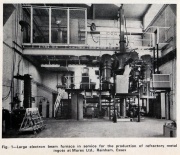Murex






of Thames House, Milbank, London (1934)
1913 The Murex Company Ltd[1] was founded in reconstruction of Murex Magnetic Co Ltd
1918 The company manufactured tungsten from Wolfram ores made available by the Ministry of Munitions; premises had been acquired in Essex[2] (Rainham)
1920 Further reconstruction as Murex Ltd
Between 1928 and 1937 Murex bought other premises on the water-front at Rainham[3]
1929 Acquired the goodwill, patents and trademarks of Thermit Ltd, a company which was owned by ICI[4]; acquired Pure Metal Manufacturing Co Ltd[5]
1930 Acquired from ICI 91.77 percent of the share capital of Premier Electric Welding Co and the 75 percent it owned of a subsidiary electric welding company[6]
1930 Murex acquired Alloy Welding Processes, Ltd. [7]
1931 Formed an American subsidiary
1931 Formed a subsidiary Murex Welding Processes Ltd
1933 Several additions to the business had been made at Rainham; the separations business continued satisfactorily; demand for the manufactured alloys had improved[8]
1934 Manufacturer of tungsten powder and alloy, iron founder and owner of an electric welding business; owner of patent rights for ore separation and concentration[9]
1934 Pure Metal Manufacturing ceased trading[10]
1935 In conjunction with Johnson, Matthey and Co, which controlled some fabrication patents, the company formed 2 new companies for production and fabrication of magnesium alloys - Magnesium Metal and Alloys Ltd and Magnesium Castings and Products Ltd[11]
1936 Murex purchased the interests of Johnson Matthey in Magnesium Metal and Alloys[12]
1938 Moved into new, larger factory
1944 Established Protolite to handle sales of tungsten carbide products[13]
1946 Premises were at Rainham and Waltham Cross; the company withdfrew from magnesium-related business[14]
1948 Began production of tungsten carbide mining bits at a subsidiary in South Africa; continued R&D at Rainham and Waltham Cross[15]
By 1951 the Powder Metallurgy Division was in Rainham (see adverts)
1950-52 Erected and staffed a Beryllium factory at Milford Haven as an Agency factory for the UKAEA[16]
1952 New research building opened at Rainham and plans developed for extension of the R&D facilities at Waltham Cross[17]
1955 Withdrew from the copper refining activity because it was unprofitable but continued with ferro-chrome despite low prices[18]. A pilot plant for extraction and fabrication of Zirconium metal was established with an eye on the developing interest in atomic energy[19]
1957 Increased demand for tanatalum and niobium powders was being met from a pilot plant established after several years R&D but a new production plant would also be constructed[20]
1959 Established Thermit Welding (Great Britain) Ltd as a subsidiary[21]
1960 Sold the Milford Haven Beryllium factory to Consolidated Beryllium Ltd[22]
1963 Drop in demand for ferro-alloys especially for the aircraft industry but many other product areas more or less maintained production even though costs rose[23]
1967 Acquired by British Oxygen Co which saw useful fit with its welding activities and the specialist metal activities[24]
See Also
Sources of Information
- ↑ The Times Nov 07, 1941
- ↑ The Times, Apr 30, 1918
- ↑ [1] British History online
- ↑ The Times, Jan 19, 1929
- ↑ The Times, Oct 03, 1929
- ↑ The Times Dec 05, 1929
- ↑ The Times, Jun 12, 1930
- ↑ The Times, Oct 06, 1933
- ↑ The Times, Sep 22, 1934
- ↑ The Times Nov 08, 1944
- ↑ The Times, Oct 18, 1935
- ↑ The Times, Oct 16, 1936
- ↑ The Times, Nov 08, 1944
- ↑ The Times, Oct 31, 1946
- ↑ The Times, Sep 02, 1948
- ↑ The Times Sep 03, 1957
- ↑ The Times, Oct 01, 1953
- ↑ The Times, Sep 06, 1955
- ↑ The Times Sep 06, 1955
- ↑ The Times , Apr 29, 1957
- ↑ The Times Sep 05, 1961
- ↑ The Times Jul 26, 1960
- ↑ The Times, Sep 03, 1963
- ↑ The Times , Jun 14, 1967

